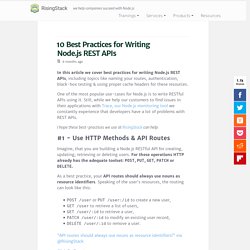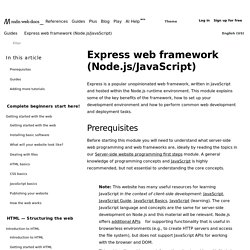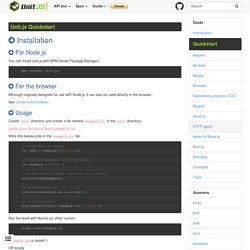

10 Best Practices for Writing Node.js REST APIs. In this article we cover best practices for writing Node.js REST APIs, including topics like naming your routes, authentication, black-box testing & using proper cache headers for these resources.

One of the most popular use-cases for Node.js is to write RESTful APIs using it. Still, while we help our customers to find issues in their applications with Trace, our Node.js monitoring tool we constantly experience that developers have a lot of problems with REST APIs. I hope these best-practices we use at RisingStack can help: #1 - Use HTTP Methods & API Routes Imagine, that you are building a Node.js RESTful API for creating, updating, retrieving or deleting users.
As a best practice, your API routes should always use nouns as resource identifiers. POST /user or PUT /user:/id to create a new user,GET /user to retrieve a list of users,GET /user/:id to retrieve a user,PATCH /user/:id to modify an existing user record,DELETE /user/:id to remove a user. #2 - Use HTTP Status Codes Correctly Restify. Express Web Framework (Node.js/JavaScript) - Learn web development.
Express is a popular unopinionated web framework, written in JavaScript and hosted within the node.js runtime environment.

The module explains some of the key benefits of this framework, how to set up your development environment and how to perform common web development and deployment tasks. PrerequisitesEdit. Unit.js Quickstart - Unit JS. Installation For Node.js You can install Unit.js with NPM (Node Package Manager). npm install unit.js For the browser Although originally designed for use with Node.js, it can also be used directly in the browser.

See Unit.js in the browser. Usage Create test directory and create a file named example.js in the test directory. path/your/project/test/example.js. Écrire un service REST avec NodeJS et Express – partie 1/3: implémentation de départ. Une fois n’est pas coutume, je découperai ce tutorial en plusieurs articles distincts, histoire de voir si j’arrive à écrire des articles plus courts Nous allons voir en détail comment mettre en place un webservice RESTful avec NodeJS et le framework Express.

L’objet de ce webservice sera la gestion d’une base de favoris. Sommaire MÀJ Oups, j’avais oublié la partie pour réellement jouer avec notre service ^^ Conception Présentation des briques logicielles Commençons par définir les outils dont on va s’armer pour mener notre mission à bien L’architecture « Representational State Transfer » consiste principalement en la mise en place de services basés sur le protocole HTTP pour les opérations standard de « CRUD« . La notion de service RESTful est très normée, et quelques règles doivent être respectées pour se réclamer RESTful: Ces normes permettent aux utilisateurs des services RESTful de savoir toujours où ils mettent les pieds, et il est donc très important de les respecter.
NodeJS et Express. Build Node.js RESTful APIs in 10 Minutes. What is REST?

REST is an acronym for Representational State Transfer. It is web standards architecture and HTTP Protocol. The REST architectural style describes six constraints that were originally communicated by Roy Fielding in his doctoral dissertation and defines the basis of RESTful-style as: Uniform InterfaceStatelessCacheableClient-ServerLayered SystemCode on Demand (optional) RESTful applications use HTTP requests to perform four operations termed as CRUD (C: create, R: read, U: update, and D: delete). RESTful is composed of methods such as; base URL, URL, media types, etc. In this tutorial, we will learn how to create a RESTful API using Node.js. Tools: Getting started For the purpose of this tutorial, I’ll work you through creating a RESTful API. Assumptions I presume that you already have your environment set up (i.e Node.js and MongoDB is installed). Kindly run npm -v and mongo --version as these will show you the version of NPM and MongoDB installed on your machine.
Server setup. 10 Best Practices for Writing Node.js REST APIs.